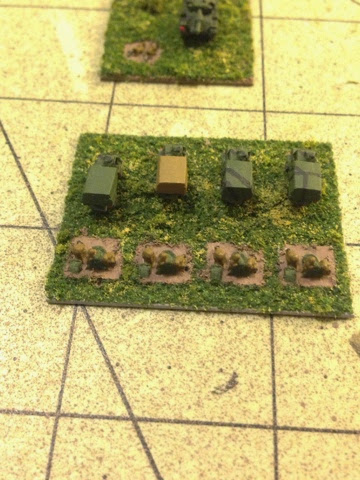Let's take one of my units at random to use as an example: this East German T-55 battalion for a motor rifle regiment:
A WarPac armored battalion in reality would have been 3 companies of 12 tanks each, which I do model at 1:1. Where I fudge a bit is the command stands. Each company stand, which I model individually, should be one tank and a 5 ton truck. The battalion command stand actually should have a UAZ-469, a BTR-60PB, a BRDM-2, and a tank. Rather crowded! The staff vehicles add nothing as far as combat value goes. They would just add atmosphere and "pretty up" the command stands.
Before I started 3mm, I settled on a stand size that allowed me to model whole platoons on a single stand, as well as a smaller size for command. No matter what era or scale you game in, there's always going to be a balance that has to be struck between realism and playability (not to mention storability and affordability). Modeling every last staff and maintenance vehicle would add quite a lot of time, expense, and eat up a lot more space on stands. Command stands could no longer be smaller (and thus more easily picked out on the tabletop) than platoon stands. So, I elected to "edit" the command stands a bit.
Years ago, when I used to be a rabid 15mm ACW gamer, I used a system (that many gamers use) to easily differentiate what level of command a given stand was, i.e. brigade, division, corps, etc. It was the number of figures on the stand. One for regimental command, two for brigade, etc. With 3mm, there are an absolute throng of command stands on the table and at 4-6ft away, it's a bit of a task to remember where your battalion or brigade commander is. So I've decided to go back and rework my command stands in the ACW style.
From now on, I'll have one vehicle for company level, two for battalion, and three for regiment/brigade. I don't foresee ever needing a divisional commander, but if I do, it'll get four. One of the main chores of 3mm wargaming is keeping straight what everything is and what goes with what. This will ease the burden, even if only a bit. So this weekend, I'm painting up the few extra Land Rovers and UAZ-469's I'll need and squirreling them onto my battalion command stands. I'll also need to order some 1/600 Mungas from Shapeways to add to my West German command stands.
More as the weekend passes.
























































